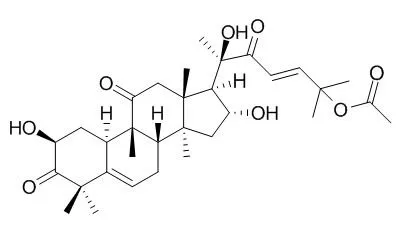| Description: |
Cucurbitacin B, an effective HIF-1 inhibitor, has antitumor activity, it inhibits proliferation and induces apoptosis via STAT3 pathway inhibition in A549 lung cancer cells. It inhibited AKT signaling activation through up-regulation of PTEN. |
| Targets: |
PKA | cAMP | HIF | mTOR | Akt | ERK | JAK | STAT | p53 |
| In vitro: |
| Eur Rev Med Pharmacol Sci. 2014;18(21):3297-303. | | Cucurbitacin B inhibits neuroblastoma cell proliferation through up-regulation of PTEN.[Pubmed: 25487942] | Cucurbitacins belong to a class of highly oxidized tetracyclic triterpenoids. Recent studies suggest that the use of Cucurbitacin could repress cancer cell progression. However, the biological effect of Cucurbitacin-B in neuroblastoma cells remains unexplored.
METHODS AND RESULTS:
MTT and BrdU (bromodeoxyuridine) incorporation assays were used to determine the anti-proliferation roles of Cucurbitacin-B. Real-time PCR and Western blot assays were used to detect the expression of cell cycle regulators. Small interfering RNAs (siRNAs) were used to silence the expression of PTEN (phosphatase and tensin homolog gene).We found that Cucurbitacin-B inhibited growth and modulated expression of cell-cycle regulators in SHSY5Y cells. At the molecular level, we found that Cucurbitacin-B inhibited AKT signaling activation through up-regulation of PTEN. Indeed, PTEN deficiency using siRNA oligos attenuated the anti-proliferative roles of Cucurbitacin-B.
CONCLUSIONS:
These results provide evidence for a mechanism that may contribute to the antineoplastic effects of Cucurbitacin-B in neuroblastoma.
| | PLoS One. 2014 Apr 1;9(4):e93547. | | VASP activation via the Gα13/RhoA/PKA pathway mediates cucurbitacin-B-induced actin aggregation and cofilin-actin rod formation.[Pubmed: 24691407] | Cucurbitacin B (CuB), a potent antineoplastic agent of cucurbitacin triterpenoids, induces rapid disruption of actin cytoskeleton and aberrant cell cycle inhibiting carcinogenesis. However, the underlying molecular mechanism of such anticancer effects remains incompletely understood.
METHODS AND RESULTS:
In this study, we showed that CuB treatment rapidly induced vasodilator-stimulated phosphoprotein (VASP) phosphorylation (i.e. activation) at the Ser157 residue and generated VASP clumps which were co-localized with amorphous actin aggregates prior to the formation of highly-ordered cofilin-actin rods in melanoma cells. Knockdown of VASP or inhibition of VASP activation using PKA-specific inhibitor H89 suppressed CuB-induced VASP activation, actin aggregation and cofilin-actin rod formation. The VASP activation was mediated by cAMP-independent PKA activation as CuB decreased the levels of cAMP while MDL12330A, an inhibitor of adenylyl cyclase, had weak effect on VASP activation. Knockdown of either Gα13 or RhoA not only suppressed VASP activation, but also ameliorated CuB-induced actin aggregation and abrogated cofilin-actin rod formation.
CONCLUSIONS:
Collectively, our studies highlighted that the CuB-induced actin aggregation and cofilin-actin rod formation was mediated via the Gα13/RhoA/PKA/VASP pathway. |
|
| In vivo: |
| Eur J Pharmacol. 2014 Jan 15;723:46-54. | | Cucurbitacin B inhibits the translational expression of hypoxia-inducible factor-1α.[Pubmed: 24333213] | Cucurbitacin B is a triterpenoid compound isolated from Trichosanthes kirilowii Maximowicz, which has been used in oriental medicine for its antitumor activities. However, the mechanisms by which Cucurbitacin B inhibits tumor growth are not fully understood.
METHODS AND RESULTS:
We here demonstrated the effect of Cucurbitacin B on hypoxia-inducible factor-1 (HIF-1) activation. Cucurbitacin B showed the potent inhibitory activity against HIF-1 activation induced by hypoxia in various human cancer cell lines. This compound markedly decreased the hypoxia-induced accumulation of HIF-1α protein dose-dependently, whereas it did not affect the expressions of HIF-1β. Further analysis revealed that Cucurbitacin B inhibited HIF-1α protein synthesis, without affecting the expression level of HIF-1α mRNA or degradation of HIF-1α protein. Rather, we found that suppression of HIF-1α accumulation by Cucurbitacin B correlated with strong dephosphorylation of mammalian target of rapamycin (mTOR) and its effectors ribosomal protein S6 kinase (p70S6K) and eukaryotic initiation factor 4E-binding protein-1 (4E-BP1) and extracellular signal-regulated kinase-1/2 (ERK1/2), a pathway known to regulate HIF-1α expression at the translational level. Cucurbitacin B also activated Akt, a mechanistic feature exhibited by established mTOR inhibitors in many tumor cells. Furthermore, Cucurbitacin B prevented hypoxia-induced expression of HIF-1 target genes and suppresses the invasiveness of tumor cells. In vivo studies further confirmed the inhibitory effect of Cucurbitacin B on the expression of HIF-1α proteins, leading to a decrease growth of HeLa cells in a xenograft tumor model.
CONCLUSIONS:
These results show that Cucurbitacin B is an effective inhibitor of HIF-1 and provide new perspectives into the mechanism of its anticancer activity. |
|






 Cell. 2018 Jan 11;172(1-2):249-261.e12. doi: 10.1016/j.cell.2017.12.019.IF=36.216(2019)
Cell. 2018 Jan 11;172(1-2):249-261.e12. doi: 10.1016/j.cell.2017.12.019.IF=36.216(2019) Cell Metab. 2020 Mar 3;31(3):534-548.e5. doi: 10.1016/j.cmet.2020.01.002.IF=22.415(2019)
Cell Metab. 2020 Mar 3;31(3):534-548.e5. doi: 10.1016/j.cmet.2020.01.002.IF=22.415(2019) Mol Cell. 2017 Nov 16;68(4):673-685.e6. doi: 10.1016/j.molcel.2017.10.022.IF=14.548(2019)
Mol Cell. 2017 Nov 16;68(4):673-685.e6. doi: 10.1016/j.molcel.2017.10.022.IF=14.548(2019)